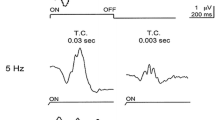Abstract
Purpose: To perform an electrophysiological study of central areolar choroidal dystrophy (CACD) in the affected members of a four generation family. Methods: Eight affected family members from the last three generations of a family affected by CACD were assessed by full-field electroretinograms (rod response, maximal combined response, oscillatory potentials, single-flash cone response and 30Hz flicker responses) and electro-oculograms. In addition three members of the youngest generation, who were visually asymptomatic, had pattern visual evoked potentials (PVEPs) and pattern electroretinograms (PERGs) performed. Affected status had been determined previously by genetic analysis. Results: Three youngest generation family members, who were considered affected by genetic haplotype analysis, had no visible optic nerve or retinal abnormalities. All of these subjects had abnormal PVEPs and PERGs in both eyes. Abnormalities were also detected in two of these subject's Rod ERGs, Cone ERGs and one of these subject's Maximal ERGs and 30Hz ERGs. Electrophysiological examination in the older generations demonstrated a similar, more advanced, cone and rod dysfunction. Conclusions: All affected, but clinically normal, youngest generation patients had bilaterally abnormal PVEPs and PERGs. In CACD the PVEP and PERG proved to be the most sensitive electrophysiological tests of preclincial macular dysfunction, 3/3 subjects abnormal. ERG recording to ISCEV guidelines were very useful in these cases; 7/8 subjects abnormal. The EOG was less useful; 4/8 subjects abnormal. CACD produces a widespread photoreceptor dysfunction in its later stages.
Similar content being viewed by others
References
Carr RE. Central areolar choroidal dystrophy. Arch Ophthalmol 1965; 73: 32–35.
Franceschetti A, Francois J, Babel J. Les Hérédo-dégénérescences choriorétiniennes. Paris: Masson, 1963; 627–646.
Hutter H, Marquardt R. Central Areolar Choroidal Atrophy with autosomal dominant inheritance. Klinische Monatsblätter fur Augenheilkunde 1989; 195; 177–180.
Noble KG. Central areolar choroidal dystrophy. Am J Ophthalmol 1977; 84: 310–318.
Sandvig K. Familial, Central, Areolar, Choroidal Atrophy of Autosomal Dominant Inheritance. Acta Ophthalmol 1955; 33: 71–78.
Hoyng CB, Deutman AF. The development of central areolar choroidal dystrophy. Graefes Arch Clin Exp Ophthalmol 1996; 234: 87–93.
Reig C, Serra A, Gean E, Vidal M, Arumi J, et al. A point mutation in the RDS-peripherin gene in a Spanish family with central areolar choroidal dystrophy. Ophthal Paed Genet 1995; 16: 39–39.
Hoyng CB, Heutink P, Testers L, Pinckers A, Deutman AF, et al. Autosomal-dominant central areolar choroidal dystrophy caused by a mutation in codon-142 in the peripherin/ rds gene. Am J Ophthalmol 1996; 121: 623–629.
Wroblewski JJ, Wells JA, Eckstein A, Fitzke F, Jubb C, et al. Macular dystrophy associated with mutations at codon 172 in the human retinal degeneration slow gene. Ophthalmol 1994; 101: 12–22.
Carr RE. Hereditary choroidal disease. In: Ryan SJ, ed. Retina. St. Louis, Baltimore, Boston, Chicago, London, Madrid, Philadelphia, Sydney, Toronto: Mosby, 1994
Krill AE. The electroretinographic and electrooculographic findings in patients with macular lesions. Trans Am Acad Ophth & Otol 1975; 79: 796–816.
Francois J, De Rouck A, Fernandez-Sasso D. Electroretinography and electrooculography in diseases of the posterior pole. Adv Ophthalmol 1969; 21: 132–163.
Deutman AF. The hereditary dystrophies of the posterior pole of the eye. Springfield, 1971.
Carr RE, Mittl RN, Noble KG. Choroidal Abiotrophies. Trans Am Acad Ophth & Otol 1975; 79: 796–816.
Zrenner E, Nowicki J, Adamczyk R. Cone function and cone interaction in hereditary degenerations of the central retina. Doc Ophthalmol 1986; 62: 5–12.
Ponjavic V, Andreasson S, Ehinger B. Full-field electroretinograms in patients with central areolar choroidal dystrophy. Acta Ophthalmol 1994; 72: 537–544.
Rothman RJ. Photoreceptor Dysfunction in Central Areolar Choroidal Dystrophy. Anal Ophthalmol 1994; 26: 25–30.
Small KW, Gehrs K. Clinical study of a large family with autosomal dominant progressive cone degeneration. Am J Ophthalmol 1996; 121: 1–12.
Lotery AJ, Ennis K, Silvestri G, Nicholl S, McGibbon D, et al. Localisation of a gene for central areolar choroidal dystrophy to chromosome 17p. Hum Mol Genet 1996; 5: 705–708.
Krill AE. Hereditary retinal and choroidal diseases. Harper and Row, 1977; 939–961.
Marmor MF, Arden GB, Nilsson SE, Zrenner E. Standard for electroretinography. Doc Ophthalmol 1990; 73: 303–311.
Marmor MF, Zrenner E. Standard for clinical electro-oculography. International Society for Clinical Electrophysiology of Vision. Doc Ophthalmol 1993; 85: 115–124.
Marmor MF. An updated standard for clinical electrophysiology. Arch Ophthalmol 1995; 113: 1375–1376.
Arden GB, Carter RM, Hogg CR, Powell DJ, Ernst WJK, Clover GM, Lyness AL and Quinlan. A modified ERG technique and the results obtained in X-linked retinitis pigmentosa. Br J Ophthalmol 1983; 67: 419–430.
Adachi-Usami E, Murayama K, Yamamoto Y. Electroretinograms and pattern visually evoked cortical potentials in central areolar choroidal dystrophy. Doc Ophthalmol 1990; 75: 33–40.
Author information
Authors and Affiliations
Rights and permissions
About this article
Cite this article
Lotery, A.J., Silvestri, G. & Collins, A.D. Electrophysiology findings in a large family with central areolar choroidal dystrophy. Doc Ophthalmol 97, 103–119 (1998). https://doi.org/10.1023/A:1002024028861
Issue Date:
DOI: https://doi.org/10.1023/A:1002024028861




